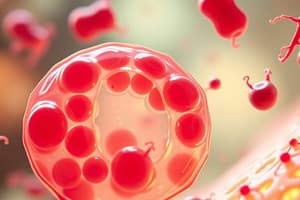Podcast
Questions and Answers
What role do lysosomes play in cellular digestion?
What role do lysosomes play in cellular digestion?
- They transport substances across the cell membrane.
- They synthesize new proteins.
- They break down macromolecules and cellular debris. (correct)
- They provide energy through ATP production.
Which of the following best describes the structure of lysosomes?
Which of the following best describes the structure of lysosomes?
- They are composed of a rigid cell wall.
- They are surrounded by a phospholipid bilayer that maintains an acidic internal environment. (correct)
- They have a phospholipid bilayer that maintains an alkaline internal environment.
- They contain hydrolytic enzymes that function at a neutral pH.
What is the primary method by which lysosomes recycle damaged organelles?
What is the primary method by which lysosomes recycle damaged organelles?
- Endocytosis
- Autophagy (correct)
- Exocytosis
- Phagocytosis
Which statement about lysosomal storage diseases is accurate?
Which statement about lysosomal storage diseases is accurate?
Which of the following statements highlights the importance of lysosomes in research?
Which of the following statements highlights the importance of lysosomes in research?
Flashcards are hidden until you start studying
Study Notes
Overview of Lysosomes
- Definition: Lysosomes are membrane-bound organelles found in eukaryotic cells that contain digestive enzymes.
- Function: They break down macromolecules, cellular debris, and foreign pathogens, playing a crucial role in cellular digestion and waste processing.
Structure
- Membrane: Surrounded by a phospholipid bilayer that maintains an acidic internal environment.
- Enzymes: Contains around 50 different hydrolytic enzymes (e.g., proteases, lipases, glycosidases) that function optimally at pH 5.
Formation
- Origin: Formed from the Golgi apparatus as vesicles that bud off containing enzymes.
- Activation: Enzymes are activated by the acidic environment and are often glycosylated to protect the lysosomal membrane from digestion.
Functionality
- Autophagy: Breaks down damaged organelles and proteins, recycling their components for cellular use.
- Phagocytosis: Engulfs and digests large particles or pathogens through endocytosis.
- Endocytosis: Digests substances taken up by the cell from the external environment.
Pathologies
- Lysosomal Storage Diseases: Conditions caused by enzyme deficiencies (e.g., Tay-Sachs, Gaucher's disease), resulting in the accumulation of undigested substrates.
- Role in Aging: Impairments in lysosomal function may contribute to age-related diseases.
Importance in Research
- Biomarkers: Indicators of cellular health and disease; studied for potential therapeutic targets.
- Cellular Signaling: Involved in signaling pathways that regulate cell metabolism, growth, and apoptosis.
Key Tips
- Remember that lysosomes are often referred to as the "cell's recycling center."
- They maintain homeostasis within the cell by controlling the breakdown and removal of waste products.
- Understanding lysosomal function is critical for insights into various diseases and potential treatments.
Lysosomes: Cellular Recycling Centers
- Definition: Membrane-bound organelles present in eukaryotic cells.
- Function: Responsible for breaking down macromolecules, damaged cell parts, and foreign pathogens.
- Key Role: Crucial for cellular digestion and waste processing.
Structure:
- Phospholipid Bilayer: Encloses the lysosome, maintaining an acidic internal environment.
- Hydrolytic Enzymes: Contains approximately 50 different enzymes optimized for acidic pH (5).
- Examples of Enzymes: Proteases, lipases, glycosidases.
Formation:
- Origin: Formed from the Golgi apparatus as vesicles that bud off.
- Enzymes: Contains enzymes that are activated by the acidic environment.
- Protection: Enzymes are protected by glycosylation, preventing them from digesting the lysosomal membrane.
Functionality:
- Cellular Cleanup: Breaks down damaged organelles and proteins for recycling.
- Phagocytosis: Engulfs and digests large particles or pathogens through endocytosis.
- Endocytosis: Digests substances taken up from the cell's external environment.
Pathologies:
- Lysosomal Storage Diseases: Occur due to enzyme deficiencies, leading to the accumulation of undigested substances.
- Examples: Tay-Sachs and Gaucher's disease.
- Aging: Impairments in lysosomal function may contribute to age-related diseases.
Importance in Research:
- Potential Targets: Studied for potential therapeutic targets due to their role in cellular processes.
- Biomarkers: Can serve as indicators of cellular health and disease.
- Cellular Signaling: Involved in signaling pathways regulating cell metabolism, growth, and apoptosis.
Studying That Suits You
Use AI to generate personalized quizzes and flashcards to suit your learning preferences.



